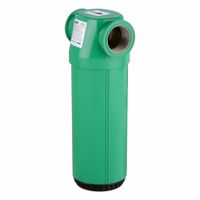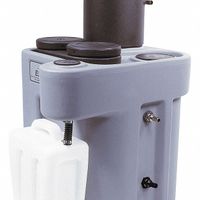Call +(254) 703 030 000 / 751 483 999 / 721 704 777
- Home
- Pneumatics
- Compressed Air Treatment
- Compressed Air Separators
.....Read More
Frequently Asked Questions
What is the purpose of a compressed air separator?
A compressed air separator is designed to remove contaminants from compressed air systems, ensuring the air is clean and dry before it reaches the end-use equipment. The primary purpose of a compressed air separator is to eliminate moisture, oil, and particulate matter that can accumulate in compressed air systems. These contaminants can cause significant damage to pneumatic tools, machinery, and processes, leading to increased maintenance costs, reduced efficiency, and potential downtime.
Moisture is a common byproduct of air compression, and if not removed, it can lead to corrosion, rust, and microbial growth within the system. Oil, often used for lubrication in compressors, can also enter the air stream and cause similar issues. Particulate matter, such as dust and dirt, can clog and damage equipment.
Compressed air separators work by employing various mechanisms such as centrifugal force, coalescing filters, or adsorption materials to separate and remove these contaminants. Centrifugal separators use a spinning motion to force heavier particles and liquids to the outer walls, where they are collected and drained away. Coalescing filters trap fine oil aerosols and water droplets, allowing them to coalesce into larger droplets that can be easily removed. Adsorption materials, like activated carbon, are used to capture oil vapors and odors.
By ensuring the delivery of clean, dry air, compressed air separators enhance the reliability and longevity of equipment, improve product quality, and maintain the efficiency of industrial processes. They are essential components in industries such as manufacturing, food and beverage, pharmaceuticals, and any other sector that relies on compressed air systems.
How does a compressed air liquid separator work?
A compressed air liquid separator is a device used to remove liquid contaminants from compressed air systems. It operates based on several principles to ensure efficient separation of liquids, such as water and oil, from the air stream.
1. **Centrifugal Action**: The separator typically uses a centrifugal action to separate liquids. As compressed air enters the separator, it is directed into a spiral or tangential path, creating a spinning motion. This centrifugal force pushes the heavier liquid droplets outward against the separator's walls, while the lighter air continues through the center.
2. **Coalescing**: Some separators incorporate coalescing elements, which are fine filters that capture small liquid droplets. These droplets coalesce, or combine, into larger droplets that are easier to separate from the air stream.
3. **Gravity Separation**: Once the liquid droplets are forced to the walls of the separator, gravity causes them to collect at the bottom of the separator. The design often includes a sump or collection chamber where the separated liquid accumulates.
4. **Automatic Draining**: To maintain efficiency, separators are equipped with automatic drains that periodically or continuously remove the collected liquid from the system. This prevents re-entrainment of the liquid into the air stream.
5. **Baffle Plates**: Some designs include baffle plates that further disrupt the air flow, enhancing the separation process by providing additional surfaces for liquid droplets to coalesce and fall out of the air stream.
Overall, the combination of these mechanisms ensures that the compressed air is effectively stripped of liquid contaminants, protecting downstream equipment and improving system efficiency.
What are the benefits of using an oil/water separator in a compressed air system?
An oil/water separator in a compressed air system offers several benefits:
1. **Environmental Compliance**: It helps in meeting environmental regulations by ensuring that oil is not discharged into the environment. This prevents potential fines and legal issues associated with improper disposal of oily wastewater.
2. **Cost Savings**: By separating oil from water, the system reduces the volume of waste that needs to be treated or disposed of as hazardous waste, leading to lower disposal costs.
3. **System Efficiency**: Removing oil from the compressed air system prevents oil from contaminating downstream equipment, which can lead to reduced efficiency, increased maintenance, and potential equipment failure.
4. **Extended Equipment Life**: By preventing oil contamination, the separator helps in prolonging the life of air tools, pneumatic machinery, and other equipment that rely on clean compressed air.
5. **Improved Air Quality**: Ensures that the compressed air is free from oil contaminants, which is crucial for applications requiring high air quality, such as food processing, pharmaceuticals, and electronics manufacturing.
6. **Reduced Maintenance**: Minimizes the need for frequent cleaning and maintenance of the air system and downstream equipment, saving time and labor costs.
7. **Safety**: Reduces the risk of oil-related hazards, such as fires or slips, by ensuring that oil is properly managed and not allowed to accumulate in the system or workplace.
8. **Sustainability**: Supports sustainable practices by reducing environmental impact and promoting the responsible use of resources.
Overall, an oil/water separator is a critical component in maintaining the efficiency, safety, and compliance of a compressed air system.
How do you maintain a compressed air separator?
To maintain a compressed air separator, follow these steps:
1. **Regular Inspection**: Conduct routine visual inspections to check for any signs of wear, corrosion, or damage. Ensure all connections and seals are intact.
2. **Drain System Maintenance**: Regularly check and clean the automatic drain system to prevent blockages. Manual drains should be opened periodically to remove accumulated condensate.
3. **Filter Element Replacement**: Replace filter elements as per the manufacturer's recommendations or when pressure drop across the separator increases, indicating clogging.
4. **Pressure Monitoring**: Monitor the pressure differential across the separator. A significant increase may indicate a need for maintenance or filter replacement.
5. **Cleaning**: Clean the separator housing and internal components to remove any dirt or oil buildup. Use appropriate cleaning agents that do not damage the materials.
6. **Check for Leaks**: Regularly check for air leaks around the separator and repair any found to maintain efficiency.
7. **Lubrication**: Ensure moving parts, if any, are properly lubricated according to the manufacturer's guidelines to prevent wear and tear.
8. **Calibration**: Periodically calibrate any sensors or gauges associated with the separator to ensure accurate readings.
9. **Documentation**: Keep detailed records of maintenance activities, including inspections, replacements, and repairs, to track the separator's performance and anticipate future needs.
10. **Training**: Ensure personnel involved in maintenance are adequately trained and familiar with the specific model and manufacturer's instructions.
11. **Environmental Considerations**: Ensure the separator is operating in a suitable environment, free from excessive dust, moisture, or temperature extremes that could affect performance.
By adhering to these maintenance practices, you can ensure the efficient operation and longevity of your compressed air separator.
What types of contaminants can compressed air separators remove?
Compressed air separators are designed to remove various types of contaminants from compressed air systems to ensure the air is clean and suitable for its intended use. The primary types of contaminants they can remove include:
1. **Water**: Moisture is a common contaminant in compressed air systems. Separators can remove liquid water and water vapor, preventing corrosion, equipment damage, and product spoilage.
2. **Oil**: Oil can enter the compressed air system from lubricated compressors. Separators help remove oil aerosols and vapors, which can cause contamination in sensitive applications like food processing or pharmaceuticals.
3. **Particulates**: Dust, dirt, and other solid particles can be present in the air or introduced during the compression process. Separators can filter out these particulates to prevent wear and tear on equipment and ensure product quality.
4. **Microorganisms**: Bacteria, fungi, and other microorganisms can be present in the air. While separators can remove some of these, additional filtration or sterilization methods may be necessary for applications requiring sterile air.
5. **Hydrocarbons**: In addition to oil, other hydrocarbons can be present in the air. Separators can help reduce these contaminants, which is crucial for maintaining air quality in sensitive environments.
6. **Rust and Scale**: Corrosion and scale from pipes and tanks can flake off and enter the air stream. Separators can capture these particles, protecting downstream equipment and processes.
By effectively removing these contaminants, compressed air separators help maintain the efficiency, reliability, and safety of compressed air systems across various industries.
How often should compressed air separators be replaced or serviced?
Compressed air separators should be serviced regularly to ensure optimal performance and longevity of the compressed air system. The frequency of servicing or replacement depends on several factors, including the type of separator, the operating environment, and the manufacturer's recommendations.
1. **Routine Maintenance**: Generally, it is advisable to inspect and service compressed air separators every 3 to 6 months. This routine maintenance includes checking for blockages, cleaning the separator, and ensuring that all components are functioning correctly.
2. **Operating Hours**: For systems that operate continuously or in demanding environments, more frequent servicing may be necessary. In such cases, monthly inspections might be required to prevent any potential issues.
3. **Environmental Conditions**: In environments with high levels of dust, moisture, or other contaminants, separators may need more frequent attention. These conditions can lead to faster clogging and reduced efficiency, necessitating more regular cleaning and maintenance.
4. **Manufacturer's Guidelines**: Always refer to the manufacturer's guidelines for specific maintenance schedules and procedures. These guidelines are tailored to the design and materials of the separator and provide the best practices for maintaining its performance.
5. **Performance Monitoring**: Implementing a performance monitoring system can help in determining the optimal maintenance schedule. By tracking pressure drops and efficiency, you can identify when a separator is underperforming and requires servicing.
6. **Replacement**: While regular maintenance can extend the life of a separator, replacement is typically necessary every 1 to 3 years, depending on usage and environmental factors. Signs that a separator needs replacement include persistent pressure drops, reduced air quality, and visible wear or damage.
By adhering to these guidelines, you can ensure that your compressed air system operates efficiently and reliably.
What are the environmental benefits of using oil/water separators?
Oil/water separators offer several environmental benefits by effectively managing and treating wastewater containing oil and other hydrocarbons. These benefits include:
1. **Pollution Prevention**: By separating oil from water, these systems prevent oil and other harmful substances from entering natural water bodies, thereby reducing water pollution and protecting aquatic ecosystems.
2. **Protection of Aquatic Life**: Oil can be toxic to fish and other aquatic organisms. By removing oil from wastewater, separators help maintain healthier habitats for aquatic life, supporting biodiversity.
3. **Soil Protection**: Preventing oil from entering water systems also reduces the risk of soil contamination. This is crucial for maintaining soil health and preventing the disruption of terrestrial ecosystems.
4. **Compliance with Regulations**: Many regions have strict environmental regulations regarding the discharge of oil-laden water. Oil/water separators help facilities comply with these regulations, reducing the risk of legal penalties and promoting environmentally responsible practices.
5. **Resource Recovery**: Some oil/water separators allow for the recovery and recycling of oil, turning waste into a resource. This reduces the demand for new oil extraction, conserving natural resources and reducing the environmental impact associated with oil production.
6. **Reduction of Wastewater Treatment Load**: By removing oil and grease before wastewater reaches municipal treatment plants, separators reduce the load on these facilities, enhancing their efficiency and effectiveness in treating other pollutants.
7. **Prevention of Infrastructure Damage**: Oil can cause blockages and damage to sewage systems. By removing oil, separators help maintain the integrity of wastewater infrastructure, reducing maintenance costs and environmental risks associated with system failures.
Overall, oil/water separators play a crucial role in minimizing environmental harm, promoting sustainability, and supporting the health of ecosystems.

